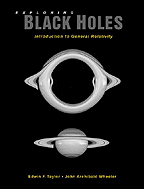
General Relativity
| Second Edition Available for Free Download |
|
The first edition of this book is now out of print, an evolving version of the SECOND EDITION is available for free download on this website. |
Exploring Black Holes
Introduction to General Relativity
Edwin F. Taylor and
John Archibald Wheeler
Addison Wesley Longman
Albert Einstein told us that a star or other massive object distorts spacetime in its vicinity. Sufficient distortion makes it impossible to describe matter and motion with the single "inertial reference frame" used in Newton's theory of mechanics and Einstein's theory of special relativity. General relativity describes the distortion of spacetime near a star, white dwarf, neutron star, or black hole and predicts the resulting motion of stones, satellites, and light flashes.
Learning general relativity usually requires mastering Einstein's field equations, which are expressed in the complicated mathematics of tensors or differential forms. But big chunks of general relativity require only calculus if one starts with the metric describing spacetime around Earth or black hole. Expressions for energy and angular momentum follow, along with predictions for the motions of particles and light. Students study the Global Positioning system, precession of Mercury's orbit, gravitational red shift, orbits of light and deflection of light by Sun, frame-dragging and precession near a rotating body, gravitational waves, and two different models of the Universe.
The evolving SECOND EDITION of this book is available for download from this web site.
Software for plotting general-relativistic (and Newtonian) orbits plus student exercises are available for download at this website.
copyright 2024, Edwin F. Taylor, All Rights Reserved
eftaylor631@gmail.com
